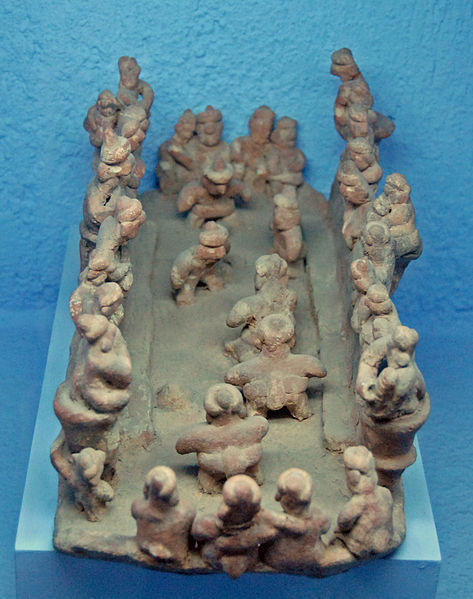casethejointfirst:ancientpeoples:A Mesoamerican ballcourt is a large masonry str
casethejointfirst:ancientpeoples:A Mesoamerican ballcourt is a large masonry structure of a type used in Mesoamerica for over 2,700 years to play the Mesoamerican ballgame, particularly the hip-ball version of the ballgame. More than 1,300 ballcourts have been identified, 60% in the last 20 years alone. Although there is a tremendous variation in size, in general all ballcourts are the same shape: a long narrow alley flanked by two walls with horizontal, vertical, and sloping faces. Although the alleys in early ballcourts were open-ended, later ballcourts had enclosed end-zones, giving the structure an I-shape when viewed from above.Ballcourts were also used for functions other than, or in addition to, ballgames. Ceramics from western Mexico show ballcourts being used for other sporting endeavours, including what appears to be a wrestling match. It is also known from archaeological excavations that ballcourts were the sites of sumptuous feasts, although whether these were conducted in the context of the ballgame or as another event entirely is not as yet known. The siting of the most prominent ballcourts within the sacred precincts of cities and towns, as well as the votive deposits found buried there, demonstrates that the ballcourt were places of spectacle and ritual.The earliest ballcourts were doubtless temporary marked off areas of compacted soil much like those used to play the modern ulama game, the Mesoamerican ballgame’s descendant. Paso de la Amada, Soconusco, along the Pacific coast boasts the oldest ballcourt yet identified, dated to approximately 1400BCE. This narrow ballcourt has a 80 x 8 m (260 ft x 26 ft) flat playing alley defined by two flanking earthen mounds with “benches” running along their length.By the Early Classic, ballcourt designs began to feature an additional pair of mounds set some distance beyond the ends of the alley as if to keep errant balls from rolling too far away. By the Terminal Classic, the end zones of many ballcourts were enclosed, creating the well-known I-shape.Many – or even most – Maya depictions of ballgame play are shown against a backdrop of stairs. Conversely, Maya staircases will occasionally feature reliefs of ballgame scenes or ballgame-related glyphs on their risers. The most famous of these are the Hieroglyphic Stairs at Structure 33 in Yaxchilan, where 11 of the 13 risers feature ballgame-related scenes. In these scenes, it appears as if the players were actually playing the ballagainst the stairs in what would seem to be a Maya version of stoop ball.The association of stairs and the ballgame is not well understood. Linda Schele and Mary Miller propose that the depictions record historic events and in particular record a “form of play … distinct from the game conducted on the courts”, one that “probably followed immediately after[ward] on steps adjacent to the ballcourts”. Other researchers are skeptical. Marvin Cohodas, for example, proposes that the “stairs” are instead stepped platforms associated with human sacrifice, while Carolyn Tate views the Yaxchilan stair scenes as “the Underworld segment of acosmogram”.No discussion of stairs as spectator space? Clearly these weren’t private events… -- source link
#archaeology#mexico#mesoamerica#ballcourt


